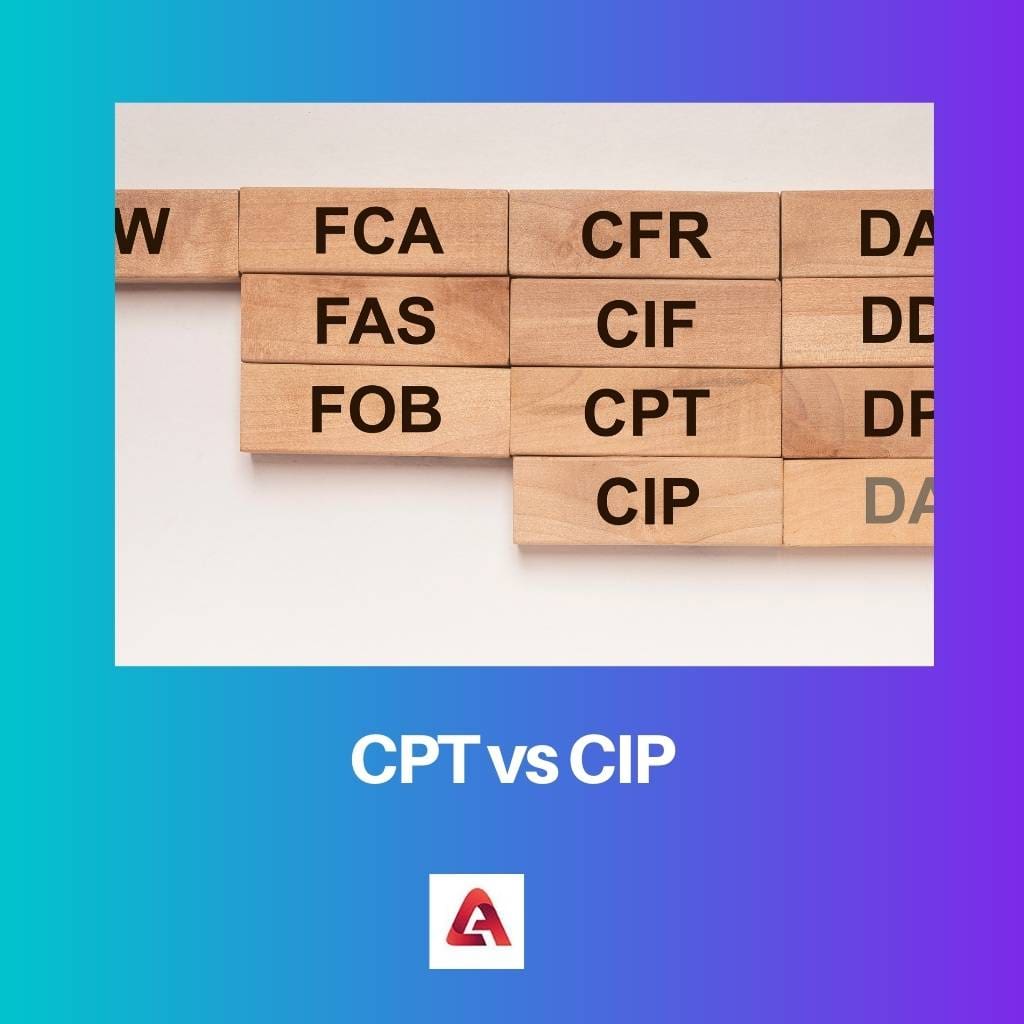Shipping terms or incoterms are three letters universally accepted and identified terminologies. It has been decided that the shipping cost will be paid by the person who ships or receives it.
Key Takeaways
- CPT or Carriage Paid To is a shipping term that means the seller is responsible for shipping the goods to the agreed destination and paying for the shipping costs. In contrast, CIP or Carriage and Insurance Paid To mean that the seller is responsible for shipping the goods to the agreed destination and paying for the shipping costs and insurance.
- CIP provides more comprehensive coverage than CPT, including insurance coverage for the goods during transit, while CPT only covers shipping costs.
- The buyer’s responsibility begins at the point of delivery in CPT, while the buyer’s responsibility begins at the point of shipment in CIP.
CPT vs CIP
CPT means that the seller is responsible for delivering the goods to a specified place, and the buyer pays for the transport costs up to that point. CIP means the seller is responsible for providing the goods to a selected area and arranging and paying for insurance coverage during transit. CIP offers additional protection for the buyer as they are covered for any damage or loss during transit, while CPT only requires the seller to deliver the goods to a specified place.

Carriage paid to is abbreviated as CPT. The shipping term signifies that the seller is responsible for transporting the freight to a mutually agreed destination without paying the insurance for the goods. When the consumer receives the goods from the seller, the ownership, risks, and responsibilities are transformed to the buyer.
Carriage and insurance paid to are abbreviated as CIP. Just like in CPT, here, too, the risks and responsibilities are taken over by the seller.
Comparison Table
| Parameters of Comparison | CPT | CIP |
|---|---|---|
| Definition | It means carriage paid to, where the seller takes charge of the goods until it reaches the seller’s hands. | Carriage insurance paid to is the term that signifies the goods are taken care of and insured by the seller. |
| Insurance | The seller does not pay insurance for the goods. | The seller ensures the goods for safety purposes. |
| The risk involved | Since there is no insurance, there are no risks involved. | Due to the insurance, there is much less risk involved. |
| Payment responsibility | The seller is entirely responsible for the transportation charges. | The seller pays a part of the insurance, and the receiver settles the rest. |
| Mode of transport | This incoterm applies to all modes of transportation. | This incoterm is applicable specifically for inland and sea modes of transport. |
What is CPT?
In CPT, the risk is less for the buyer than for the seller, as the seller takes most of the responsibilities. Though the seller has to assume significant responsibility, it still benefits the seller by urging the buyers and motivating them to confidently take up the service as they do not have to do much. The seller does everything, and the buyer is also not at risk.
The seller can make a bid deal with the policy as many buyers are ready and feel safe to let the seller take responsibility. This can significantly benefit buyers and encourage them to do it without hesitation.
In some cases, it is also inclusive of the terminal handling charges. It is conveniently used as a shipping term next to a destination.

What is CIP?
In CIP, the seller pays the insurance in addition to owning the risks involved in shipping. In this mode, the seller obliges to more responsibilities than the buyer.
The seller is given a massive responsibility of paying the customs responsibilities, loading fee, delivery cost, and the expense of pre-shipment inspections, in addition to the insurance for the goods. The proof of delivering the goods and licenses are also the tasks of the seller.
Though the seller carries the maximum obligations, the buyer must do their part to ensure they receive the freight safely and intact. The buyers arrange the duties and the facilities for importing the goods.
They are also supposed to pay for their goods mutually decided and agreed upon by both parties in the contract. The goods are transported and delivered through inland means and water modes of transport while implying the CIP incoterm.

Main Differences Between CPT and CIP
- CPT is carriage paid to, whereas CIP is carriage insurance paid to.
- In CPT, the seller does not insure the freight, but in CIP, goods are insured.
- Because the goods are not insured in CPT, damage may result in a loss. In CIP, the goods are insured; hence, damage may not result in a loss.
- In CPT, the seller takes a significant risk. In CIP, the buyer shares some responsibility.
- CPT is implied in any mode of transport, whereas CIP is only applied in inland and sea transportation.


The explanation of CPT and CIP is insightful and well-articulated, providing a practical guide for businesses engaging in international trade.
Absolutely, businesses can use this information to establish effective shipping agreements and manage risks accordingly.
The detailed breakdown of CPT and CIP is immensely informative and valuable for businesses navigating international trade complexities. This will be a go-to reference for many.
These terms can be confusing, but this detailed explanation helps clarify the differences between CPT and CIP.
Agreed, it’s essential for businesses to comprehend the implications of each term to make better decisions.
Absolutely, understanding these terms can prevent costly mistakes in international trade.
It’s essential to understand these terms before engaging in international trade. This gives more leverage to negotiate advantageous terms with suppliers.
Yes, knowing these terms can help to avoid misunderstandings and disputes in business transactions.
I completely agree, it’s crucial to be well-informed to make informed decisions in business.
The comparison table provides a clear breakdown of the differences, making it easier to decide which term is more suitable for specific trade transactions.
Understanding the nuances between CPT and CIP is vital for businesses to mitigate risks and ensure smooth transactions.
Definitely, having a comprehensive understanding of these terms is crucial for successful and secure international trade.